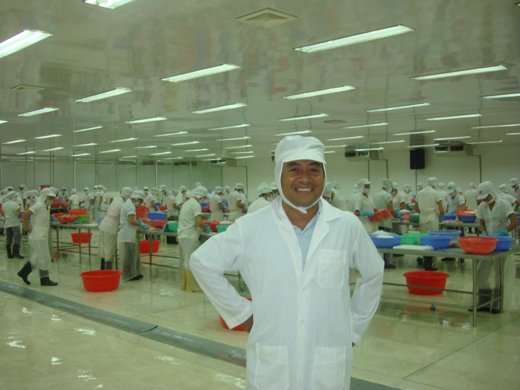quick links
partners
| The Bear is Back: Russia Returns to Vietnam |
|
The Bear is Back: Russia Returns to Vietnam
A visit to Vietnam by Vladimir Putin is just the latest sign of the former allies’ growing ties.
By Carl Thayer
November 26, 2013
President Vladimir Putin paid a whirlwind one-day visit to Hanoi on November 12 to advance the comprehensive strategic partnership reached with Vietnam last year. This was Putin’s third visit to Vietnam and his second since assuming the office of President of the Russian Federation.
Putin met Vietnam’s top three leaders, Prime Minister Nguyen Tan Dung, President Truong Tan Sang and party Secretary General Nguyen Phu Trong. At the conclusion of his visit it was announced that seventeen bilateral agreements had been reached, including five in the oil, gas and energy sectors. These agreements were a reflection of the broad-based nature of bilateral relations developed ten years after the collapse of the Soviet Union.
Vietnam’s armed forces — air defense air force, navy, armor and artillery corps — are dependent on Soviet-era spare parts and equipment and badly in need of modernization. Between 1993 and 2000, Russia sold Vietnam twelve Su-27SK and Su-27UB Flanker jet aircraft, two missile attack corvettes, four radar systems, and other military equipment.
In March 2001, the Russian Federation became Vietnam’s first strategic partner. At that time the two sides mapped out eight major areas of cooperation: political-diplomatic, oil and gas, hydro power and nuclear energy, trade and investment, science and technology, education and training, culture and tourism, military equipment, and technology.
Article 8 of the agreement on strategic partnership specified that, “The two parties will strengthen their cooperation in military supplies to meet Vietnam’s and Russia’s security demands and not to oppose any third country.â€
Between 2001 and 2008 bilateral relations were constrained by the poor state of the Russian economy; consequently the strategic partnership had very thin underpinnings. Since 2008 Russia regained political stability and its economy has been bolstered by the development of oil and gas reserves. Russia sought to exploit the market opportunities in fast growing Vietnam and the transport links between Vietnam and the Russian Far East.
Russian arms sales to Vietnam soon became a significant component of the strategic partnership.
Between 2008 and 2012, the Vietnam People’s Army Navy took delivery of two Gepard-class guided missile frigates and four Svetlyak-class fast patrol boats. The navy also procured 40 Yakhont/SS-N-26 and 400 Kh-35Uran/SS-N-25 anti-ship missiles.
In 2009, Vietnam signed a contract for the purchase of six advanced Project 636 Varshavyanka (Kilo-class) conventional submarines.
Vietnam’s air defense air-force took delivery of twenty Su-30MK2V combat aircraft armed with Kh-59MK anti-ship cruise missiles, 100 R-73 (AA-11 Archer) short-range air-to-air missiles, 200 9M311/SA-19 Grisonsurface-to-air missiles, two batteries of S-300PMU-1 surface-to-air systems, four Kolchnya air defense search radars and three VERA passive radio locators. Vietnam also took delivery of two batteries of the K-300PBastion coastal defense missiles.
On July 27, 2012, Presidents Putin and Sang met in the resort city of Sochi and adopted a Joint Statement raising their bilateral relations to a comprehensive strategic partnership. Russian arms sales and service contracts to Vietnam now became the most significant component of their bilateral relations.
Since 2012, Vietnam has placed an order for twelve more Su-30MK2s aircraft and two Gepard 3.9-class frigates configured for anti-submarine warfare. Russia also was given the contract to construct a military ship maintenance and repair facility at Cam Ranh Bay.
On the eve of Putin’s November visit to Vietnam, Russia loaded Vietnam’s first Kilo-class submarine on a transporter for delivery to Vietnam and announced it would hand over a submarine crew training center that it was building in Cam Ranh Bay in January 2014.
At the conclusion of Putin’s visit this month, a Joint Statement was issued that briefly mentioned an agreement on defense cooperation had been reached without providing any details. Media reports and other official statements indicated that Russia would be heavily involved in servicing armaments and military equipment that it sold to Vietnam, and transferring military technology for licensed co-production. For example, it is likely that Vietnam and Russia will co-produce the Uran (SS-N-25 Switchblade) anti-ship cruise missile.
In an interview on November 9, on the eve of President Putin’s arrival, President Sang called for the two countries to “raise military cooperation to a higher plane.†In order “to create a new breakthrough†in the comprehensive strategic partnership, Sang also proposed “joint venture production, in research, in setting up service centers and after sales service as well as in exports to third countries.â€
President Putin, in a statement issued prior to his arrival in Hanoi, noted that, “military and technical co-operation has taken a totally new dimension. It is no longer limited to export supplies, steps are being taken to launch the licensed production of advanced military equipment with the assistance of Russian companies in Vietnam.â€
Russia is currently pressing Vietnam to give it exclusive access to the military ship repair, maintenance and logistics facilities being constructed at Cam Ran Bay.
Current and projected Vietnamese military acquisitions have generated a pressing need for appropriate maintenance, repair and training services that only Russian defense enterprises can provide. In addition, Russia has offered to expand the number of billets at its military academies to train Vietnamese military personnel.
Australian Admiral James Goldrick (retired) recently noted with respect to Vietnam’s purchase of six Kilo-class submarines that “the Vietnamese are trying to do something very quickly that no navy in recent times has managed successfully on such a scale from such a limited base.†He concluded, “the new boats may have significant numbers of Russians on board for years to come.… Russian experts will certainly be need ashore.â€
In sum, “the bear†is coming back to Vietnam. In the coming years, Russian companies will assist Vietnam in servicing and maintaining the high end military platforms, equipment and armaments that it has purchased from Russia. Russian defense companies will assist Vietnam in co-producing a variety of missiles and armaments that will be fitted to its new air and sea platforms. And Russian military personnel and other specialists will assist Vietnam in developing its submarine fleet.
Russian military facilities at Cam Ranh Bay also can be expected to resupply and repair Russian Navy ships in transit from the Far East to the Gulf of Aden and back. As the November 14 Joint Statement revealed, Russian-Vietnamese oil and gas joint ventures will continue to explore and produce hydrocarbons on Vietnam’s continental shelf. Russia and Vietnam therefore will have congruent interests in peace and stability in the South China Sea. |






























